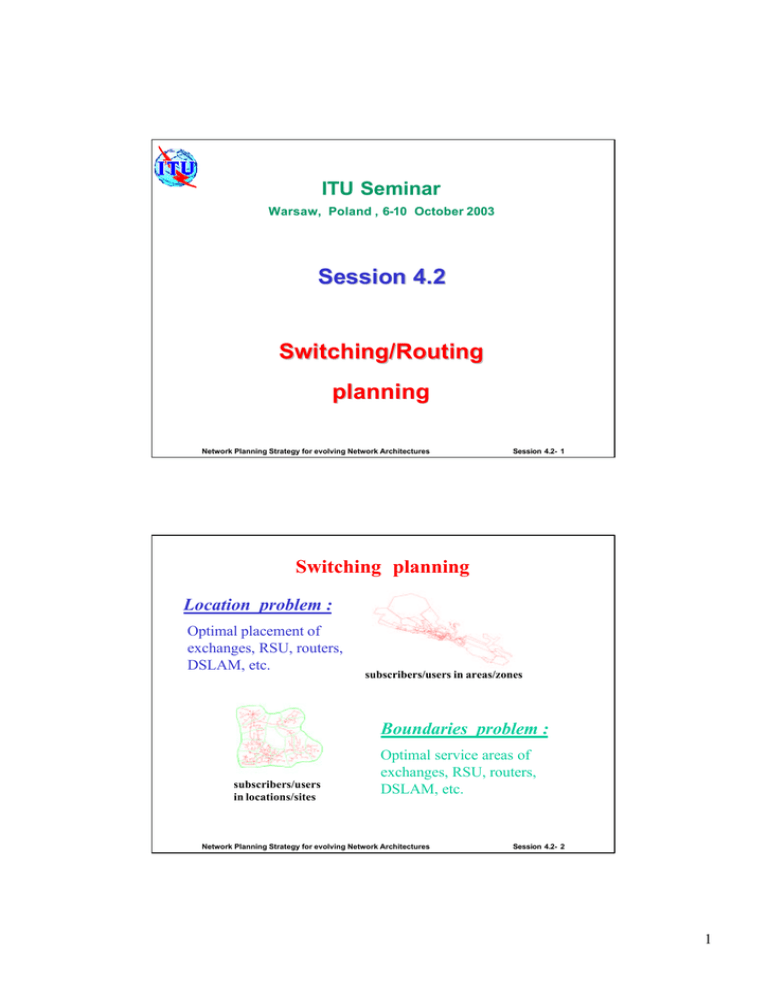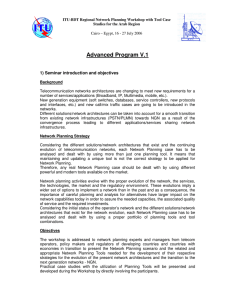Session 4.2 Switching/Routing planning
advertisement

ITU Seminar Warsaw,, Poland , 6-10 October 2003 Warsaw Session 4.2 Switching/Routing planning Network Planning Strategy for evolving Network Architectures Session 4.2- 1 Switching planning Location problem : Optimal placement of exchanges, RSU, routers, DSLAM, etc. subscribers/users in areas/zones Boundaries problem : subscribers/users in locations/sites Optimal service areas of exchanges, RSU, routers, DSLAM, etc. Network Planning Strategy for evolving Network Architectures Session 4.2- 2 1 Switching planning Location problem Subscriber zones / subscriber grid model => Network Planning Strategy for evolving Network Architectures Session 4.2- 3 Switching planning Location problem Theoretically for the set of optimal location (XE,YE) the partial derivatives of the total network ∂C ∂X = 0 E cost function, C, with regard to for E = 1,2, K NEX ∂C ∂ YE = 0 XE and YE are equal to zero : Different methods for solving this 2*E equation system could be employed depending upon the methods of measuring the distances in the network In the most complicated case we get a system of 2*NEX non-linear equations If ∂C ∂X E and ∂C ∂ YE are expanded into Taylor-series this leads to a system of 2*NEX linear equations in ∆X F and ∆YF , which can easily be solved by standard methods Network Planning Strategy for evolving Network Architectures Session 4.2- 4 2 Switching planning Location problem - distance measurement methods Mean distance from exchange to grid element : (x 2 , y2 ) The mean distance from to the rectangle can then be found from: (x, y) Ly (X E ,YE ) 1 D= area (x1 , y1 ) x2 y2 ∫ ∫ d ( X E ,YE , x , y ) dx dy x1 y1 Lx (XE , YE ) along the hypotenuse : along the cathetie : D( X E ,YE , x , y ) = ( X E − x ) 2 ⋅ L2x + ( YE − y ) 2 ⋅ L2y D ( X E , Y E , x, y ) = X E − x + Y E − y Network Planning Strategy for evolving Network Architectures Session 4.2- 5 Switching planning Simplified method for location optimization Based on the access network cost S j only : S j = ∑ sub( i , j ) ⋅ Cs( DE ) For optimal locations (XE ,YE ) the partial derivatives of the cost function C= Sj with regard to XE and YE are equal to zero : For a case with one location only for XE we get: for ( i , j ) ∈ E i ∂ C ∂X E = ∂C ∂X E = 0 ∂C ∂YE = 0 ∑ [sub(i, j) ⋅ C ( D ( i , j )∈E c E for E = 1,2,K NEX ) ⋅ ∂DE ∂X E ] the partial derivative depends only on the distance Network Planning Strategy for evolving Network Architectures Session 4.2- 6 3 Switching planning Simplified method for location optimization With simplified distance method along the cathetie : ∂C ∂X E = We get : Thus : Or : D ( X E , YE , i, j) = X E − j + YE − i − 1 if j ≥ X E sub(i , j ) ⋅ Cc ( DE ) ⋅ i , j ∈E 1 if X E ≥ j ∑ ( ) ∑ sub(i , j ) ⋅ C (D c (i , j )< X ∑ sub(i , j ) ⋅ C ( D c (i , j )<X Finally if disregard the tr. media cost (same everywhere) we get: E )= E ).(+ 1) + ∑ sub(i, j ) ⋅ C ( D ∑ sub( i, j ) ⋅ C ( D c (i , j )> X c ( i, j )> X E E ).(−1) = 0 ) sub (i, j ) = ∑ sub(i , j ) ∑ ( ) ( ) i, j <X Network Planning Strategy for evolving Network Architectures i,j >X Session 4.2- 7 Switching planning Example locations Optimum location according to the simplified method is the median of the accumulated subscribers sum – 4033 is within row 5 (Y=R5) Network Planning Strategy for evolving Network Architectures Session 4.2- 8 4 Switching planning Location problem Graph model (subscribers in nodes) => Network Planning Strategy for evolving Network Architectures Session 4.2- 9 Switching planning Location problem - graph model Graph model presents network nodes and links connecting these nodes - cost function, C, is a discrete function over all node locations, i.e. it is not possible to use partial derivatives of C Obvious solution is to calculate the total network cost, C, for all combinations (solutions) and find the smallest C = Cmin Distances calculation as distances on graph – shortest path problem and corresponding algorithms For n nodes and N equipment items n! cost combinations (n-N)! N! Network Planning Strategy for evolving Network Architectures Session 4.2- 10 5 Switching planning Location problem - graph model Check all combinations - for very small networks pointless to investigate many of the combinations Heuristic methods - eliminate the obvious senseless combinations and investigate only some of the combinations Probabilistic methods for location optimization - Simulated annealing / Simulated allocation / Genetic algorithms Network Planning Strategy for evolving Network Architectures Session 4.2- 11 Switching planning Boundaries problem grid model graph model Network Planning Strategy for evolving Network Architectures Session 4.2- 12 6 Switching planning Boundaries problem Boundary optimization is finding service/exchange area boundaries in such a way that total network costs is minimized The cost of connecting one subscriber at location (x,y), belonging to traffic zone K, to an exchange/node E at ( X E ,YE ) can thus be expressed as : C ( E ) = C j ( K , E ) + Cb ( E ) + DE ⋅ C s ( DE ) + C f It depends of the cost of connecting the subscriber, the average exchange cost per subscriber, the backbone network cost of any subscriber The decision for the boundary can be made simply by comparison for every grid/node element (i,j) – the value C(E) is calculated for every exchange /node E and the lowest C(E) then determines E Network Planning Strategy for evolving Network Architectures Session 4.2- 13 Switching planning Example boundaries v Grid element with 271 subscribers on a distance of 10 steps to upper exch. and 11 lo lower exch. – attach to service area of upper exch. v Grid element with 86 subscribers on a distance of 11 steps to upper exch. and 10 lo lower exch. – attach to service area of lower exch. v Boundary between grid elements 271 and 86 Network Planning Strategy for evolving Network Architectures Session 4.2- 14 7 Routing planning transiting of traffic High-usage route – part of the traffic is carried on the direct route and the rest of the traffic overflows through a tandem Direct routing 5 3 hierarchical network high-usage routes 4 Optimum final routes 1 2 Dual homing (load sharing) C(N) alternative routes NOPT Primary routes with Poisson-type offered traffic ND N Circuits Network Planning Strategy for evolving Network Architectures Session 4.2- 15 Routing planning Dual homing (load sharing) overflowing traffic is divided with predefined coefficient α Disjoint Routing Problem of Virtual Private Networks (VPN) – demands must be routed through a network so that their paths do not share common nodes or links VN VT SF-A Combinatorial optimization SZ methods for non-hierarchical routing optimize routing and simultaneously optimally dimension link capacities Network Planning Strategy for evolving Network Architectures disjoint routing Session 4.2- 16 8 Routing planning IP networks typically use OSPF to find shortest routes between points – result could be that links on shortest routes are congested while other links remain idle Traffic engineering in MPLS means that traffic flows can be controlled in order to balance link loads. Quality of service control in MPLS means that bandwidth can be reserved for traffic flows. LSP design problem all packets of a flow may follow the same path, the so-called label switched path LSP Packet flow in the forward and reverse directions Network Planning Strategy for evolving Network Architectures Session 4.2- 17 Routing planning OPT1 A possible optimization criterion when computing LSP designs is the minimization of the maximum arc load As a result arcs with high utilization are avoided whenever possible, so that the traffic is more uniformly distributed heuristic optimization algorithms LSP design problem OPT2 A second optimization principle is to set up the LSP design for the traffic demands along the shortest possible paths like in standard IP routing, The paths contained in a solution P are shortest paths in terms of number of arcs used Network Planning Strategy for evolving Network Architectures Session 4.2- 18 9




